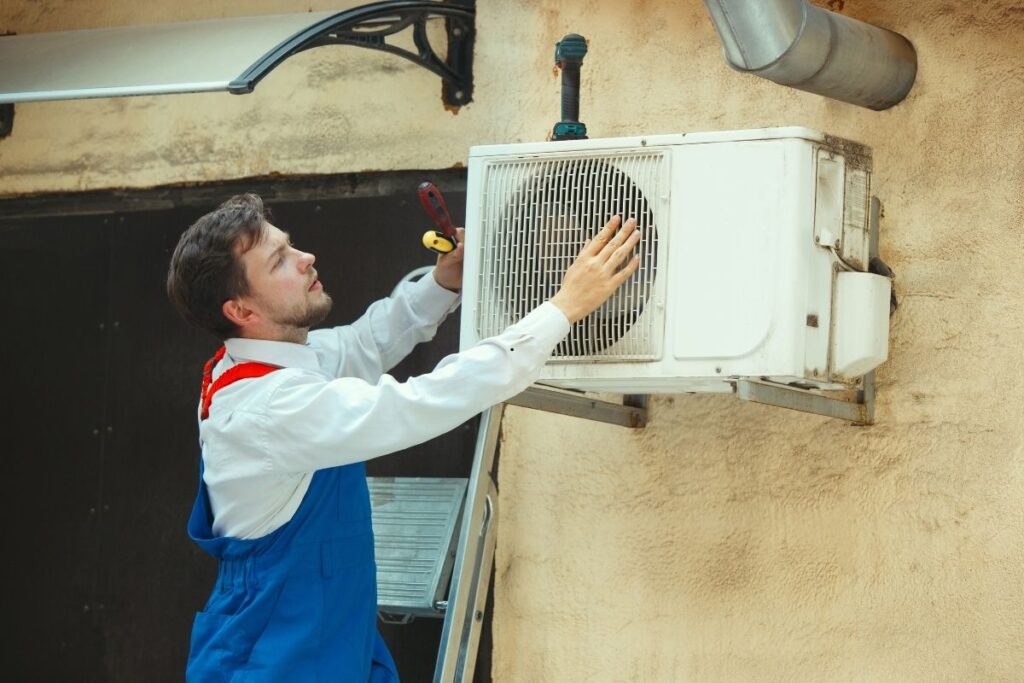The charming maritime city of Norfolk, Virginia, offers a unique blend of history, culture, and stunning waterfront views. But as any resident knows, when the warm embrace of spring turns into the sweltering, humid grip of summer, life without a functioning air conditioner quickly becomes unbearable. The persistent humidity, often laden with the tang of salt air from the Chesapeake Bay, adds another layer of discomfort and can even be detrimental to indoor air quality. So, when your AC unit decides to take an unscheduled break, it’s not just an inconvenience – it’s an emergency that demands swift, decisive action.
This comprehensive guide is designed to empower Norfolk homeowners facing an air conditioning problems.
We’ll delve into the tell-tale signs of a struggling system, equip you with safe troubleshooting steps you can try yourself, and, crucially, provide the knowledge to select a reputable AC repair service in Norfolk when professional expertise is non-negotiable. Understanding these aspects can help you restore comfort to your home, protect your investment, and potentially save you from larger, more costly repairs down the line.
When Your AC Is Crying for Help Against Norfolk’s Heat
Your air conditioner is a complex piece of machinery, and like any machine, it communicates distress signals before a complete breakdown. Recognizing these indicators can give you a crucial head start, allowing for timely intervention and potentially averting a full system failure.
- Warm Air Flowing from Vents: This is the most glaring and immediate sign. If your vents are emitting air that’s anything but cool, your AC is struggling to perform its primary function. Common culprits include low refrigerant levels, a malfunctioning compressor, a clogged air filter, or an issue with the outdoor condenser unit. In Norfolk’s humidity, warm air also means you’re not getting any dehumidification.
- Diminished Airflow: Even if the air feels cool, if it’s barely a whisper from your vents, your system isn’t circulating enough air to effectively condition your home. This often points to severely clogged air filters, blocked return air vents, issues with the blower motor, or leaks within your ductwork that are allowing conditioned air to escape before reaching your rooms.
- Unusual Noises: AC units generate some operational sounds, but anything out of the ordinary warrants attention:
- Grinding or Squealing: Often indicative of worn-out motor bearings in either the indoor blower fan or the outdoor fan motor.
- Clicking: A single click when the unit turns on or off is normal. However, rapid, continuous clicking might signal a faulty relay, contactor, or other electrical component.
- Banging or Clanking: Suggests a loose part within the fan assembly (indoor or outdoor), a loose compressor component, or even a foreign object inside the unit.
- Hissing: A common indicator of a refrigerant leak, especially if accompanied by a noticeable decline in cooling performance.
- Gurgling: While some gurgling from refrigerant circulation is normal, excessive gurgling could indicate air in the refrigerant lines or a blockage.
- Persistent Musty or Foul Odors: Your AC system should ideally not produce any discernable smell.
- Musty/Moldy Smell: Very common in humid coastal environments like Norfolk. It almost always means there’s mold or mildew growth on the evaporator coil (due to excessive moisture), within the drain pan, or in the ductwork. This isn’t just unpleasant; it can impact indoor air quality and worsen allergies or respiratory issues.
- Burning Smell: If you detect a burning odor, immediately turn off your AC system at the thermostat and the circuit breaker. This typically indicates an electrical problem, such as burnt wiring, a failing motor, or an overheating electrical component, posing a fire risk.
- Foul/Sewer Gas Smell: Less common, but can occur if the condensate drain line’s P-trap dries out (allowing sewer gases from your plumbing to enter the air handler) or if there’s dead animal in your ductwork.
- Frequent Cycling (Short-Cycling): When your AC unit turns on, runs for a very brief period (e.g., less than 10-15 minutes), then shuts off, only to repeat this cycle frequently, it’s “short-cycling.” This problem accelerates wear and tear on components, significantly wastes energy, and often fails to adequately dehumidify and cool your home. Potential causes include an improperly sized unit, low refrigerant, a severely clogged air filter, or electrical control issues.
- High Indoor Humidity: Beyond cooling, a primary function of your AC in humid climates like Norfolk is dehumidification. If your home feels uncomfortably sticky or clammy even when the thermostat temperature is set low, your AC isn’t effectively removing moisture. This can result from an oversized unit (which cools too quickly without enough runtime to dehumidify), low refrigerant levels, or issues with the evaporator coil.
- Visible Water Leaks: Puddles or drips around your indoor unit (furnace/air handler) are a clear sign of trouble. This almost always indicates a clogged condensate drain line, which prevents condensation (the water removed from the air) from draining away properly, leading to overflow and potential water damage, wood rot, or mold growth.
- Unexpected Spikes in Energy Bills: If your monthly electricity bills suddenly increase significantly without a corresponding change in your AC usage habits, your unit is likely operating inefficiently due to an underlying mechanical problem. It’s working harder than it should to achieve the desired temperature.
DIY Troubleshooting for Common AC Issues
Before you panic and dial a repair service, there are several simple, safe checks you can perform that often resolve minor issues or, at the very least, provide valuable information for a technician.
- Check Your Thermostat Settings:
- Is it set to “Cool” mode?
- Is the target temperature set lower than the current room temperature?
- Are the batteries fresh (if it uses them)?
- Is the fan set to “Auto” rather than “On” (unless you desire continuous fan operation)?
- Confirm the date and time are correct, especially on smart thermostats, as this can affect scheduling and operation.
- Inspect and Replace Your Air Filter: This is the absolute simplest and most impactful maintenance task. A clogged air filter is the number one cause of poor airflow, reduced efficiency, and even frozen evaporator coils. Check your filter monthly, and plan to replace it every 1 to 3 months, or more frequently if you have pets, allergies, or higher dust levels.
- Verify the Circuit Breaker: Head to your main electrical panel. Look for the breaker(s) labeled for your “AC,” “Furnace,” “Air Handler,” or “Condenser.” If a breaker is tripped (usually positioned halfway between ON and OFF), firmly flip it completely to the “OFF” position, then back to “ON.” CRITICAL: If the breaker trips again immediately or frequently, do NOT keep resetting it. This indicates a serious electrical fault that requires immediate professional attention and poses a fire hazard.
- Clear the Outdoor Unit (Condenser): Your outdoor unit needs proper airflow. Ensure it’s clear of any debris like leaves, grass clippings, dirt, or even overgrown shrubs and bushes. Use a garden hose (on a gentle setting) to rinse off the condenser coils. Crucially, ALWAYS turn off the power to the outdoor unit at its dedicated disconnect switch (a small box usually mounted on the wall near the unit) before cleaning or touching it.
- Look for Frozen Coils (Indoor Unit): If your indoor unit (air handler) has ice buildup on its refrigerant lines or coils, it’s frozen. This happens when there’s insufficient airflow across the coil (dirty filter, blocked vents) or low refrigerant.
- What to do: Turn off your AC unit at the thermostat, but leave the fan running (set it to “ON” or “Fan Only”). This will help melt the ice. This process can take several hours, potentially half a day or more. While it’s thawing, address potential causes like changing a dirty filter or clearing blocked return/supply vents. Once the ice is completely melted, restart your AC. If it freezes again quickly, the underlying problem (likely low refrigerant or a persistent airflow issue) needs professional diagnosis.
- Address Condensate Drain Line Clogs: If you’re seeing water leaks around your indoor unit, locate the condensate drain pan (typically underneath the indoor unit) and the PVC drain pipe. If it’s clogged, water will back up and overflow. You can often clear minor clogs by using a wet/dry vacuum at the exterior end of the drain line (which usually terminates near your foundation). Pouring a cup of distilled vinegar into the access point near the indoor unit can also help prevent future algae buildup.
When to Call the Norfolk AC Repair Experts
While DIY efforts can tackle straightforward issues, many AC problems demand the specialized tools, in-depth knowledge, and certified experience of a professional HVAC technician. Never attempt complex repairs involving refrigerant handling, high-voltage electrical components, or internal unit diagnostics unless you are a qualified and licensed expert.
It’s time to call an AC repair professional in Norfolk if you encounter:
- Complete Loss of Cooling: Beyond simple thermostat or tripped breaker fixes.
- Any Burning Smell or Electrical Arcing: These are serious safety hazards. Turn off the power immediately.
- Signs of Refrigerant Leak: Such as hissing sounds, persistent ice formation on the outdoor unit, or a noticeable decline in cooling capacity. Refrigerant handling requires EPA certification.
- Loud, Persistent Grinding, Banging, or Squealing Noises: Indicates failing motors, compressors, or other major components.
- Frequent Circuit Breaker Tripping: Signals a dangerous electrical short or an overloaded circuit.
- Continuous Short-Cycling: This prematurely ages your system and indicates a deeper problem.
- Water Leaks that you cannot easily clear or that persist.
- Any issue that makes you uncomfortable or unsure about handling yourself.

Selecting the Right AC Repair Company in Norfolk
Norfolk, being a vibrant city, offers numerous HVAC service providers. Choosing the right one is paramount for ensuring quality repairs, fair pricing, and peace of mind. Here’s what to prioritize in your search:
- Licensing and Certification: In Virginia, HVAC contractors must be licensed by the Department of Professional and Occupational Regulation (DPOR). Always ask for their license number and verify its validity online. Look for technicians who are NATE (North American Technician Excellence) certified, which signifies a high standard of technical knowledge and competence.
- Experience and Local Reputation: Opt for companies with a long-standing presence and strong reputation within the Norfolk area. Check online reviews on platforms like Google, Yelp, and the Better Business Bureau (BBB). Ask friends, family, or neighbors for personal recommendations. A company with a history of positive local service is usually a reliable choice.
- Transparent and Detailed Pricing: A reputable AC repair company will always provide a clear, written estimate before any work begins. This estimate should detail parts, labor, and diagnostic fees. Be wary of providers who give vague quotes over the phone, push for immediate high-pressure decisions, or insist on starting work without a clear cost breakdown. They should explain the problem clearly and offer repair options.
- Comprehensive Diagnostics: A skilled technician won’t simply guess at the problem. They will perform a thorough diagnostic of your entire HVAC system to accurately pinpoint the root cause, rather than just treating symptoms that might lead to recurring issues.
- Warranty on Parts and Labor: Inquire about the warranty offered on both the replacement parts and the repair labor. A good company stands behind its work and the components it installs. Typical warranties range from 30 days to a year for labor, and parts warranties vary by manufacturer.
- 24/7 Emergency Service: Given Norfolk’s climate, an AC breakdown can’t always wait for business hours. Many trustworthy companies offer emergency services for those critical, after-hours breakdowns. Confirm their availability for such situations.
- Customer Service and Communication: Pay attention to how your initial inquiry is handled. Are they professional, courteous, and responsive? Clear communication throughout the repair process is a hallmark of a well-run and customer-focused business.
Preventing Future AC Repair
The most effective “repair” is often the one you manage to avoid entirely. Regular, proactive maintenance is the single most important step you can take to extend the lifespan of your AC unit, significantly improve its efficiency, and minimize the likelihood of unexpected, costly breakdowns.
- Consistent Filter Changes: As emphasized earlier, this is your easiest and most impactful DIY task. In Norfolk’s often dusty and humid environment, monthly checks are a must, with replacements every 1-3 months.
- Annual Professional Tune-Ups: Schedule a professional AC tune-up every spring, ideally before the peak summer heat arrives. During a tune-up, a qualified technician will:
- Thoroughly clean both the outdoor condenser coils and the indoor evaporator coils.
- Verify correct refrigerant levels and pressures.
- Inspect all electrical connections and components for wear or damage.
- Lubricate moving parts to prevent friction and wear.
- Clear the condensate drain line to prevent clogs and water leaks.
- Calibrate your thermostat for accurate temperature control.
- Test the overall system’s operation to ensure it’s performing optimally.
- Keep Vents Unobstructed: Ensure that all supply and return air vents throughout your home are free from obstructions like furniture, rugs, or drapes, which can restrict airflow.
- Maintain Clear Space Around Outdoor Unit: Keep at least 2 feet of clear space around your outdoor condenser unit. This allows for proper airflow, which is critical for the unit’s efficiency and longevity. Regularly trim back any vegetation.
- Consider a Humidifier/Dehumidifier: In Norfolk’s humid climate, sometimes an AC alone can struggle. A whole-home dehumidifier or a stand-alone unit can greatly enhance comfort and reduce strain on your AC.
Facing an AC breakdown in Norfolk’s humid summer is a challenge no homeowner wants. However, by understanding the warning signs, performing basic troubleshooting, and knowing when and how to select a reputable AC repair service, you can navigate these stressful situations with confidence.






